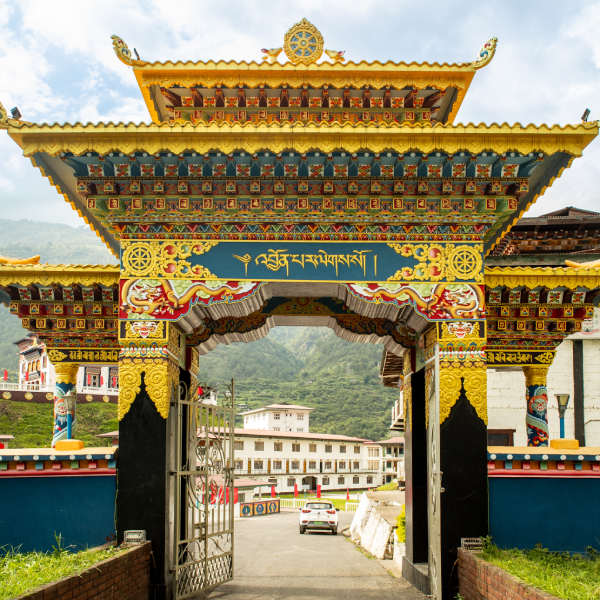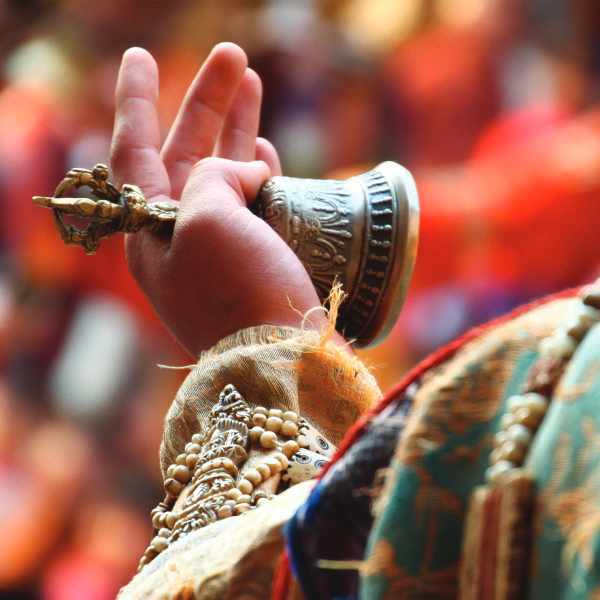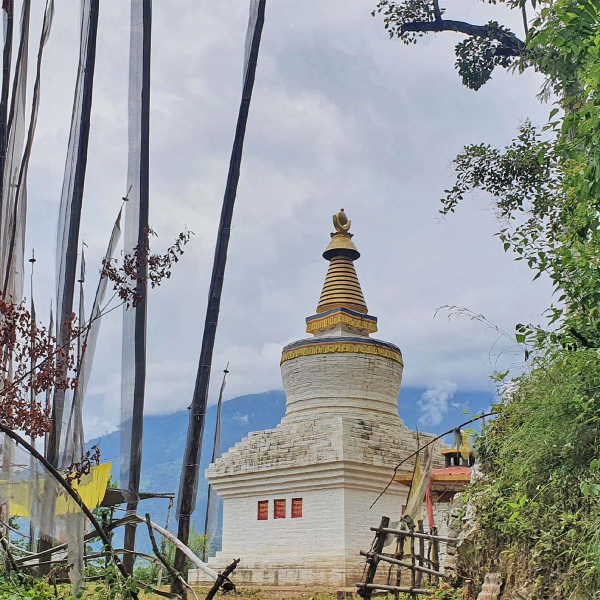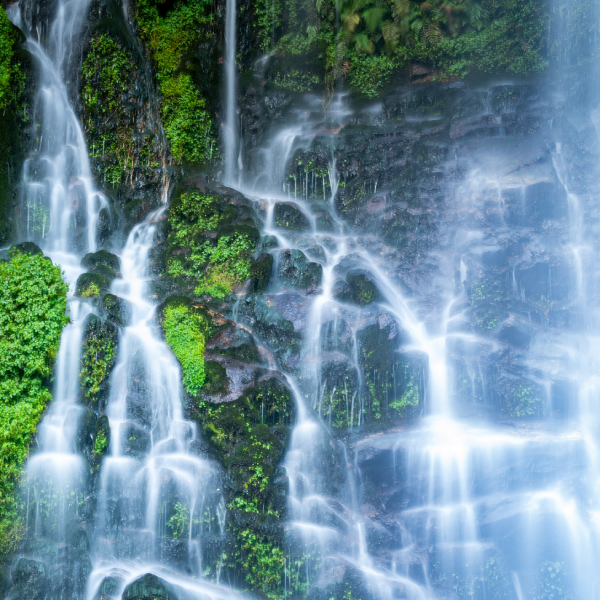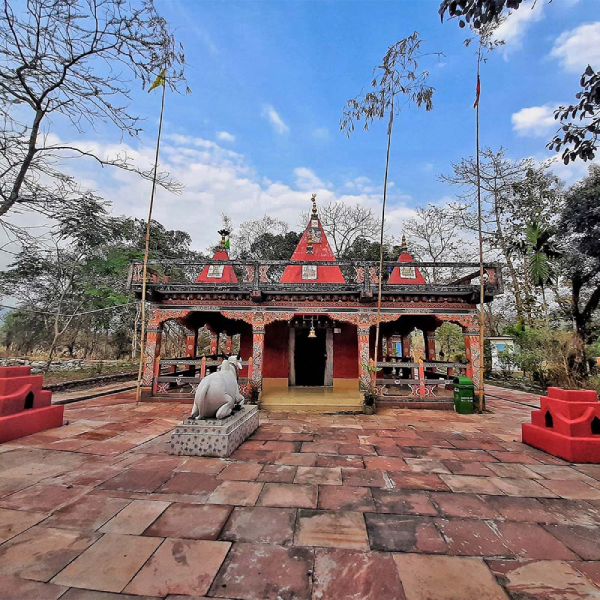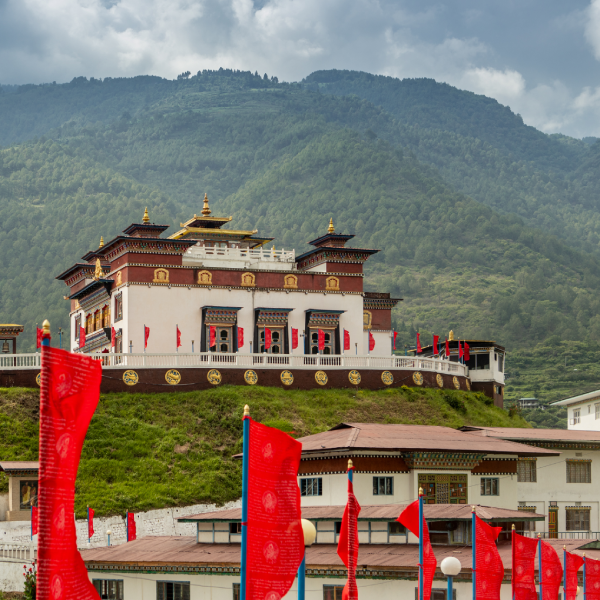Bhutan: The Last Shangri-La
Bhutan: The Last Shangri-La
Tucked away in the heart of the Eastern Himalayas, Bhutan is often hailed as the “Last Shangri-La”—a land where ancient traditions, spiritual depth, and dramatic landscapes remain untouched by time. This secluded kingdom, protected by towering peaks and cloaked in emerald forests, offers a rare glimpse into a world guided by harmony, reverence, and authenticity.
Here, timeless monasteries cling to cliffsides, fortress-like dzongs watch over serene valleys, and prayer flags flutter on mountain ridges, carrying blessings to the winds. Rooted deeply in Mahayana Buddhism, the Bhutanese people embrace a way of life defined by balance, compassion, and a profound connection to nature.
With its steadfast commitment to cultural preservation and environmental sustainability—reflected in its philosophy of Gross National Happiness—Bhutan stands as a living testament to what a mindful society can look like. For those in search of peace, beauty, and meaning, Bhutan offers more than a destination—it offers a sanctuary.
Short Itinerary
| Title | Accommodation | Meals |
| Day 01: Arrival in Paro | Hotel | -/L/D |
| Day 02: Sightseeing in Paro | Hotel | B/L/D |
| Day 03: Paro to Thimphu | Hotel | B/L/D |
| Day 04: Thimphu to Punakha | Hotel | B/L/D |
| Day 05: Punakha to Wangduephodrang to Gangtey | Hotel | B/L/D |
| Day 06: Gangtey (Phobjikha) – Trongsa | Lodge | B/L/D |
| Day 07: Trongsa – Bumthang (Jakar) | Lodge | B/L/D |
| Day 08: Sightseeing in Bumthang | Lodge | B/L/D |
| Day 09: Bumthang – Mongar | Lodge | B/L/D |
| Day 10: Mongar – Trashigang | Lodge | B/L/D |
| Day 11: Trashigang (excursion to Trashiyangtse) | Hotel | B/L/D |
| Day 12: Trashigang – SamdrupJongkhar | Lodge | B/L/D |
| Day 13: SamdrupJongkhar – Guwahati (B) | B |
Tour Program
Expand AllYour Bhutanese journey begins with one of the world’s most spectacular flights—descending into the serene Paro Valley. On a clear day, this awe-inspiring approach offers sweeping views of the towering Himalayas, including legendary peaks such as Everest, Kanchenjunga, and Makalu. As you approach Bhutanese airspace, the revered peaks of Chomolhari, Jichu Drake, and Tserimgang rise into view—standing like timeless sentinels at the gateway to the kingdom.
Upon touching down at Paro International Airport—beautifully nestled in a narrow valley at an altitude of 2,200 meters—you’ll immediately notice the fresh mountain air and sense of calm that pervades the landscape. A friendly local representative will meet you at the airport, assist with entry formalities, and guide you to your hotel. Take the rest of the day to relax, acclimate, and absorb the peaceful spirit of Bhutan that surrounds you from the very first moment.
Hotel
-/L/D
Ease into your second day in Bhutan with an enriching journey through the cultural tapestry of the Paro Valley—a region where tradition lives on amid breathtaking Himalayan scenery.
Begin with a visit to Ta Dzong, a historic circular watchtower perched above the valley that now houses Bhutan’s National Museum. Inside, wander through thoughtfully curated galleries featuring ancient armor, religious relics, ceremonial thangkas, antique coins, textiles, and natural history exhibits—each piece telling a story of Bhutan’s spiritual and cultural evolution.
From there, take a short, scenic walk down to the impressive Rinpung Dzong, also known as the “Fortress of the Heap of Jewels.” Built in the 1600s, this striking structure combines religious and administrative functions and is renowned for hosting the annual Paro Tsechu festival. Admire the dzong’s towering walls, richly adorned interiors, and its commanding view over the Paro River.
Pause midday for lunch at a local eatery, where you can savor a hearty Bhutanese meal or opt for international cuisine in a warm and welcoming setting.
In the afternoon, journey deeper into the valley to visit the evocative ruins of Drukgyel Dzong. Once a key military outpost that safeguarded Bhutan from northern invasions, the fortress now stands as a quiet sentinel of history. On clear days, gaze beyond its stone walls for a glimpse of Mount Chomolhari, Bhutan’s revered snow-capped peak.
As you return toward town, make a final stop at Kyichu Lhakhang, a sacred temple that dates back to the 7th century. One of Bhutan’s oldest and holiest sites, Kyichu continues to be a place of deep devotion and spiritual resonance, with flickering butter lamps and spinning prayer wheels adding to its serene charm.
Conclude your day back at your hotel, with your senses enriched and your spirit touched by the timeless wonders of Paro.
Hotel
B/L/D
After a hearty breakfast at your hotel in Paro, begin your journey to Thimphu, Bhutan’s lively capital nestled in a picturesque valley. The scenic drive winds through idyllic countryside dotted with traditional farmhouses, terraced rice fields, and peaceful riverside villages—offering a first-hand look at rural Bhutanese life.
En route, stop at Semtokha Dzong, a historic fortress built in 1629. Perched on a strategic hilltop, it’s considered the oldest dzong in the country. Today, it serves as the Institute for Language and Cultural Studies, where monks and students delve into Bhutan’s classical literature, history, and spiritual traditions.
Once you arrive in Thimphu, spend your afternoon engaging in a rich cultural experience:
Tashichhodzong
Step into the grandeur of Tashichhodzong—Bhutan’s seat of government and monastic authority. Flanked by manicured gardens and the Wang Chhu River, this splendid structure houses the throne room and offices of the King, as well as the central monastic body. Its elegant design showcases the finest of Bhutanese architecture.
National Memorial Chorten
Next, visit the National Memorial Chorten, a serene white stupa built in honor of Bhutan’s third king. Locals circumambulate the monument with quiet reverence, spinning prayer wheels and chanting mantras. Inside, intricate mandalas and statues illustrate Buddhist teachings and cosmic harmony.
Handicrafts Emporium
Dive into Bhutan’s artistic soul at the Handicrafts Emporium, where you’ll find an exquisite selection of locally made goods—from handwoven textiles and carved masks to thangka paintings and intricate woodwork. This is the perfect spot for authentic souvenirs and gifts.
In the early evening, enjoy a relaxed stroll through Thimphu’s bustling market streets. Absorb the city’s unique rhythm as locals gather in cafes, vendors sell seasonal fruits, and traditional garments mix effortlessly with modern attire. You may even sample some popular street snacks or visit a local teahouse for a cup of suja (butter tea).
Return to your hotel for a restful evening, reflecting on a day that blends Bhutan’s timeless traditions with its quietly modern present.
Hotel
B/L/D
On the fourth day, you'll journey from Thimphu to Punakha, experiencing cultural and natural attractions along the way. Begin your day with visits to several important cultural institutions in Thimphu:
National Library: Explore the National Library, home to an extensive collection of priceless Buddhist manuscripts and texts.
Institute for Zorig Chusum (Painting School): Visit the Painting School, where students undergo a six-year training course in Bhutan's traditional arts and crafts, known as the 13 Zorig Chusum.
National Institute of Traditional Medicine: While you can view the exterior, learn about Bhutan's renowned traditional herbal medicines and their preparation.
Lunch: Enjoy a delicious lunch in Thimphu.
After lunch, embark on a scenic drive to Punakha, passing through the picturesque Dochu-la pass, which stands at an elevation of 3,088 meters (10,130 feet). Here, you'll encounter a large Bhutanese chorten and fluttering prayer flags. On a clear day, you'll be treated to breathtaking views of the eastern Himalayan peaks. Upon reaching Punakha, check in at your hotel. Punakha was once the capital of Bhutan and continues to be the winter seat of the Je Khenpo.
Explore Punakha Dzong, a magnificent fortress built by Shabdrung Ngawang Namgyal in the 17th century. It is strategically located at the confluence of the Pho Chu (male) and Mo Chu (female) rivers, making it one of Bhutan's most iconic landmarks. The dzong's architecture and scenic location are truly captivating. After these activities, we will return to the hotel.
Hotel
B/L/D
After breakfast in Punakha, drive to Wangduephodrang. Here, you'll visit the Wangduephodrang Dzong, which is situated on a spur at the confluence of two rivers. The dzong's location offers commanding views of the valley, making it a remarkable architectural and strategic structure. Wangdue district is known for its craftsmanship, particularly in bamboo work, stone carvings, and slate production. Following your visit to Wangduephodrang, embark on a picturesque mountain drive. You'll pass through enchanting oak and rhododendron forests, winding up to a high pass before descending into the Phobjikha Valley. This valley is renowned for its stunning natural beauty and is considered one of Bhutan's most picturesque high-altitude valleys.
Once you arrive in Phobjikha, take some time to explore the valley and its surroundings. Phobjikha is unique in that it serves as the winter habitat for the black-necked cranes, which migrate here from the Tibetan plateau. The valley is not only visually striking but also ecologically important. While in Phobjikha, visit Gangtey Monastery, also known as Gangtey Gompa. This is the only Nyingmapa monastery in western Bhutan and holds religious and cultural significance. The monastery's architecture and serene location amidst the valley add to its charm. After these activities, we will return to the hotel.
Hotel
B/L/D
On the sixth day, you'll continue your journey through the stunning Bhutanese landscape, with the hope of sighting black-necked cranes in the morning. Begin your day by exploring the picturesque Phobjikha Valley. If you are visiting at the right time of year, you may have the opportunity to spot black-necked cranes, which migrate to this valley from the Tibetan plateau during the winter months. Observing these magnificent birds in their natural habitat is a unique and unforgettable experience.
After your morning exploration, drive towards Trongsa. Your journey will take you across the Pele-la Pass, which stands at an elevation of 3,300 meters (10,830 feet). Along the way, you'll be treated to stunning mountain scenery and sweeping vistas. As you continue your journey, make a stop to visit Chendebji Chorten, an 18th-century stupa built by a Tibetan lama. The chorten was constructed to cover the remains of an evil spirit that was subdued at this location. It is built in the Nepalese style and features painted eyes at the four cardinal points. The landscape around Trongsa is truly spectacular, and you'll catch your first glimpse of the impressive Trongsa Dzong as you approach the town. This dzong is stretched along a ridge above a ravine and holds historical significance as a stronghold along Bhutan's traditional trade routes. The winding road leads you into the town, where you'll check in at your lodge.
Lodge
B/L/D
On Day 7, you'll continue your Bhutanese adventure with visits to historical sites in Trongsa and a picturesque drive to the beautiful Bumthang Valley. Start your day with a visit to Trongsa Dzong, one of the most impressive dzongs in Bhutan. This dzong was constructed in 1647 by Shabdrung Ngawang Namgyal and holds a significant place in Bhutan's history. Explore the magnificent architecture and historical significance of this fortress. Next, visit Ta Dzong, which is situated on the hillside above Trongsa town. Originally built as a watchtower to guard Trongsa, it offers panoramic views of the surrounding landscape. Then, you will have your lunch in Trongsa. After lunch, embark on a scenic drive to Bumthang, which is often considered one of the most spectacular valleys in Bhutan. The journey covers a distance of approximately 68 kilometres and takes about 3 hours. As you drive, you'll encounter the Yutong-la Pass at an elevation of 3,400 meters (11,155 feet). The road winds through dense coniferous forests, offering breathtaking views of the landscape. As you continue, you'll enter the Chumey Valley, a wide, open, and cultivated valley known for its natural beauty.
Finally, arrive in Bumthang, where you will be greeted by the soft, late afternoon light. This drive offers a scenic and pleasant experience, allowing you to unwind and enjoy the serene surroundings. Bumthang is a region with a rich cultural heritage, and it's a great place to explore Bhutan's spiritual and historical roots. You can expect to encounter monasteries, temples, and a tranquil atmosphere in this sacred valley. Enjoy your stay in Bumthang and explore the local attractions at your leisure. After these activities, we will return to the lodge.
Lodge
B/L/D
Today, you'll have the opportunity to explore the enchanting Bumthang region, which comprises four valleys: Chumey, Choekhor, Tang, and Ura, each with its unique charm and altitudes ranging from 2,600 to 4,000 meters (8,530 to 13,125 feet). Begin your day with a visit to Kurje Lhakhang, one of the most sacred sites in Bhutan. This place holds special significance as it is associated with Guru Rinpoche (Padmasambhava), considered Bhutan's "patron saint." Guru Rinpoche meditated here, and the site features three temples with impressive murals and sculptures. From Kurje Monastery, you can follow a tarmac road that leads south along the right bank of the river to Jambay Lhakhang. This ancient temple, constructed by the Tibetan king Songtsen Gampo in the 7th century, is among the two oldest temples in Bhutan, the other being Kyichu Lhakhang in Paro. Enjoy a delightful lunch in Bumthang, savouring Bhutanese cuisine and taking in the serene ambience.
In the afternoon, continue your exploration by visiting Tamshing Lhakhang, founded in 1501 by the revered treasure revealer Pema Lingpa. This temple is known for its captivating ancient Buddhist wall paintings, which provide insights into Bhutanese art and spirituality. Next, explore Jakar Dzong, often referred to as "the castle of the white bird." This dzong holds historical and architectural significance and offers panoramic views of the surrounding landscape. Afterwards, take a stroll through Bumthang's market area, where you can interact with locals, shop for souvenirs, and immerse yourself in the vibrant culture of the region. After these activities, we will return to the lodge.
Lodge
B/L/D
Today, your journey takes you further eastward, and you'll continue to be treated to breathtaking vistas as you wind through the rugged terrain of Bhutan. The drive from Bumthang to Mongar is approximately 6 hours, filled with scenic beauty and memorable experiences. As you depart Bumthang, you'll ascend into the hills above the valley, passing by the picturesque Ura village. The road then takes a sharp climb to reach the highest point on Bhutan's motorable road network, Thrumsing-la Pass, which stands at an elevation of 4,000 meters (13,125 feet). This pass offers awe-inspiring views of the surrounding landscape. Later, enjoy a picnic lunch at a scenic spot along the way to Mongar. The perfect opportunity to savour a meal amidst the stunning natural surroundings. Continuing your journey, you'll gradually descend from the high altitudes of the past into the alpine valley of Sengor. Along the way, you'll be treated to views of cascading waterfalls and the picturesque hills of eastern Bhutan. As you lose altitude, you'll notice a change in vegetation from alpine to subtropical. The road will be adorned with bamboo groves and lush ferns as you drop down to the valley floor. The descent eventually leads you to the Kuri Chu River, which you'll cross at an elevation of 700 meters (2,300 feet). Afterwards, you'll ascend once more, passing through pine forests, maize fields, and charming eastern hamlets before arriving at Mongar town. This town is situated high on a gentle slope above the valley, offering beautiful views of the surrounding area.
Upon your arrival in Mongar, visit Mongar Dzong. While it is one of Bhutan's newest dzongs, having been constructed in the 1930s, it follows the same architectural traditions as all previous dzongs in Bhutan. Dzongs are impressive fortress-monasteries that are integral to the country's cultural and administrative life. After these activities, we will return to the lodge.
Lodge
B/L/D
Today’s journey spans approximately 96 kilometers and takes about 3 hours, guiding you from Mongar to Trashigang through diverse landscapes and rich cultural sites.
Your day begins with a drive through verdant forests filled with ferns, creating a tranquil and refreshing atmosphere. Soon, you’ll arrive at Kori-la Pass, sitting at 2,450 meters (8,040 feet), where a charming chorten (Buddhist stupa) and a mani wall inscribed with sacred prayers welcome you. From here, the road descends rapidly through vibrant fields of corn and banana groves.
Below the village of Yadi, the road twists through well-known switchbacks that follow the beautiful Gamri River valley. Taking a left, you’ll ascend to Drametse Monastery, proudly perched on a steep hillside. Established by Choeden Zangmo, this important monastery serves as the spiritual center of eastern Bhutan and is famed as the origin of the Drametse NgaChham, a traditional masked dance accompanied by rhythmic drumbeats.
After lunch, continue your journey to Trashigang, situated at 1,100 meters (3,610 feet). As the largest and most populous district in Bhutan, Trashigang boasts a dramatic fortress—Trashigang Dzong—commanding a rocky promontory above the Gamri River gorge. This impressive dzong serves as both the administrative hub and a monastic residence, exemplifying Bhutanese architecture and offering sweeping views of the surrounding landscape.
Conclude your day with a comfortable return to your lodge in Trashigang, where you can enjoy dinner and a peaceful overnight rest.
Lodge
B/L/D
After breakfast, set out on an enriching excursion from Trashigang to Trashiyangtse, a town steeped in cultural and historical heritage. Your first stop is Gom Kora temple, situated 24 kilometers from Trashigang on a serene alluvial plateau overlooking the river. This temple is famed for its connection to Guru Rinpoche, who is believed to have subdued a demon here, imprisoning it within a rock. Take time to explore the temple and soak in the peaceful atmosphere.
Next, proceed to Doksum village, where you’ll witness local women expertly weaving vibrant Bhutanese textiles, offering a fascinating insight into the area’s artisanal heritage. Close by, cross an ancient 15th-century suspension bridge made of chain links, a unique relic that speaks to the region’s enduring traditions.
As evening falls, return to Trashigang for dinner and a comfortable overnight stay at your lodge. Reflect on the cultural treasures and stunning natural beauty you’ve experienced in the remote eastern reaches of Bhutan.
Hotel
B/L/D
Set out on a memorable journey from Trashigang to Samdrup Jongkhar, traversing a route rich in diverse landscapes and historical significance. This road, completed in 1965, serves as a vital link between eastern Bhutan and the Indian border.
Along the way, you’ll pass Sherubtse College in Kanglung, established in 1978 and affiliated with the University of Delhi. As Bhutan’s premier degree-granting institution, it plays a key role in the nation’s higher education.
Nearby, visit Zangtho Pelri temple, a serene sanctuary built in 1978 that symbolizes Guru Rinpoche’s heavenly abode. Founded by the late Minister of Home Affairs, this temple offers a peaceful environment perfect for reflection.
After lunch, continue to Khaling, known for the National Institute for the Disabled and the Weaving Centre, where exquisite traditional Bhutanese textiles are crafted. Visits to these centers typically require prior arrangements made before departing Thimphu.
From Khaling, journey on to Deothang, a place marked by its historical role in the 19th-century Duar Wars. Finally, arrive in Samdrup Jongkhar, where you’ll settle into a comfortable lodge for the night.
As your day concludes, take time to reflect on the rich cultural heritage, stunning natural beauty, and historical landmarks that have shaped your journey through eastern Bhutan.
Lodge
B/L/D
Early morning after breakfast in Samdrup Jongkhar as you prepare for your departure from Bhutan. Today's journey will take you out of Bhutan and into the northeastern state of Assam, India. Embark on a scenic drive to Guwahati, the capital town of the Indian northeastern state of Assam. The drive will take you through the picturesque landscapes of the region, allowing you to soak in the natural beauty and local culture. Arrive in Guwahati, where you will have the option to catch a flight to Delhi, Kolkata, or another onward destination in that region. Guwahati has an airport with domestic flight connections to major cities in India for your onward journey.
B
Tour Includes
- Arrival/Departure transfers.
- Meet and assist at the airport by our representative.
- 02-night hotel accommodation in Paro on a double sharing on a full board basis.
- 01-night hotel accommodation in Thimpu on double sharing on a full board basis.
- 01-night hotel accommodation in Punakha on double sharing on a full board basis.
- 01-night hotel accommodation in Gangtey on double sharing on a full board basis.
- 01-night hotel accommodation in Trongsa on double sharing on a full board basis.
- 02-night hotel accommodation in Bumthang on double sharing on a full board basis.
- 01-night hotel accommodation in Mongar on double sharing on a full board basis.
- 02-night hotel accommodation in Trashigang on a double sharing on a full board basis.
- 01-night hotel accommodation in SamdrupJongkhar on double sharing on a full board basis.
- All the sightseeing tours and transfers as per the itinerary with English speaking local guide in Bhutan
- Bhutan Visa fee
- Tourism development fee & Entrance fee in Bhutan
- All administrative cost
- Full service & and assistance before, during, and after your Bhutan trip.
Tour Excludes
- Airfare to and from Bhutan (we can arrange tickets for you if you wish)
- Any other beverages (alcoholic or non-alcoholic) including water ordered in restaurants and hotels
- Travel or health insurance
- Wire transfer
- Laundry
- Gratuity/Tip for guides and drivers
FAQ
Expand AllØ The itinerary typically includes visits to major cities and regions in Bhutan, such as Paro, Thimphu, Punakha, Bumthang, and possibly other cultural and scenic spots.
Ø Highlights may include exploring ancient monasteries, fortresses (dzongs), traditional markets, picturesque landscapes, and experiencing the unique culture and traditions of Bhutan.
Ø Accommodations range from comfortable hotels to boutique lodges or traditional Bhutanese guesthouses, offering modern amenities while reflecting local architectural styles.
Ø Typically, breakfast, lunch, and dinner are included, featuring a variety of Bhutanese and international cuisine to cater to different tastes and dietary preferences.
Ø The best time to visit Bhutan is during the spring (March to May) and autumn (September to November) seasons when the weather is pleasant, and festivals are celebrated.
Ø Transportation includes comfortable private vehicles or coaches, ensuring convenience and safety while travelling between destinations.
Ø A moderate level of fitness is generally sufficient for most activities, though some hiking or walking may be involved, especially around monastery visits or nature trails.
Ø Bhutan's mountainous terrain may pose altitude challenges in certain areas. It's advisable to acclimatize gradually and stay hydrated, especially in high-altitude regions.
Ø Essentials include comfortable clothing suitable for layering, sturdy walking shoes, sun protection, a hat, a reusable water bottle, a camera, and any personal medications.
Ø Yes, optional activities such as traditional archery, hot stone baths, farm visits, or additional hiking excursions may be available for an extra fee.
Ø Group sizes can vary but are often kept small to facilitate a more intimate experience and ensure personalized attention from guides.
Ø Travel insurance is usually not included but highly recommended to cover unexpected events such as trip cancellations, medical emergencies, or evacuation.
Ø Respect local customs and traditions, dress modestly when visiting religious sites, remove hats and shoes when entering temples, and ask for permission before taking photographs of people.
Ø The cancellation policy varies among tour operators and may involve penalties depending on the timing of the cancellation and the terms of the booking.
Ø Booking can be done through tour operators, travel agencies, or online platforms. Payment options typically include credit/debit cards, bank transfers, or online payment platforms. It's essential to confirm reservation details and payment procedures with the tour provider.
Things to know
- Activities:
-
Cultural exploration of Bhutan’s valleys, monasteries, dzongs, and temples
-
Scenic drives through Bhutan's remote and picturesque landscapes
-
Sightseeing and hiking in historical and cultural sites like Paro Taktsang (Tiger's Nest)
-
Excursion to Trashiyangtse for a deeper understanding of Bhutanese culture
-
Explore the Phobjikha Valley, home to the endangered black-necked cranes.
-
Bumthang Valley exploration, the spiritual heart of Bhutan
-
Mongar and Trashigang, lesser-visited gems that showcase traditional rural life in Bhutan
-
- Best Time to Visit: Spring (March-May) and Autumn (Sept-Nov) for mild weather, clear skies, and vibrant cultural festivals
- Accommodation: Comfortable hotels, lodges, and guesthouses along the route
- Local Culture: Rich Bhutanese traditions, including festivals, arts, and local craftsmanship
- Fitness Level: Moderate – some scenic hikes and walking tours, including Tiger's Nest
- Weather: Temperate, with cool evenings and mild days during spring and autumn
- Permits Required: Bhutanese government-controlled permits for foreign travelers (arranged through licensed tour operators)
- Transportation: Private vehicles with a driver and guide for the journey through remote and scenic regions
- Guides: Knowledgeable local guides essential for cultural insights, navigation, and smooth travel in Bhutan's remote areas
Why Book With Us?
- Expert Knowledge
- Customized Itineraries
- Immersive Experiences
- Seamless Travel
- Safety and Comfort
- Cultural Sensitivity
- Flexible Options
- Best Tour Guides
- Unmatched Hospitality
- Personalized Support
- Sustainable Tourism
- Local Partnerships
